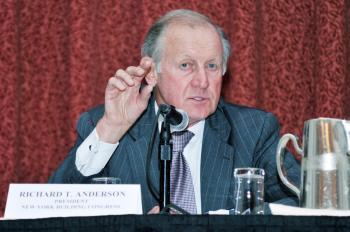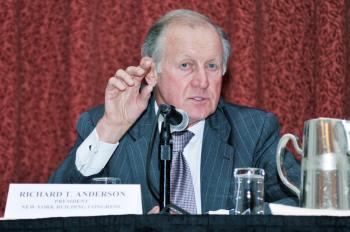NEW YORK—Reaching into the stimulus pot is the way to keep construction going, a familiar refrain, this time spoken by top local economists. But projects must be “shovel-ready” to qualify, leaving many falling “by the wayside,” said Marisa Lago, president and CEO of Empire State Development Corp (ESDC).
Lago and Robert Lieber, New York’s deputy mayor for economic development, spoke to construction industry executives at a breakfast forum April 14.
Creating and retaining jobs drew the most discussion, with host and New York Building Congress president Richard Anderson challenging Lieber on Mayor Bloomberg’s 30 percent reduction in the capital budget, calling it “unwise, ill-timed, and everything should be done to stop it.”
The cut, Anderson said, would cost an extra 10,000 jobs. “There are other ways to save $227 million.”
In the City’s defense, Lieber said the construction industry could expect to lose 60,000 to 70,000 jobs in total, but the City was working hard on creating jobs. The 30 percent reduction, Lieber said, was money that had to be diverted to “out of control” costs such as health care and pensions. “We have to be financially prudent. The one thing we can control is our spending.”
He said any changes in capital budget now will not be felt for 5 to 10 years.
Transport projects totaling $1 billion should produce 32,000 jobs, Lieber said. “The single greatest asset New York City has is its talent and we have to do everything we can to keep it.”
Big Projects Scaled Down, Still Moving
The EDSC oversees many of the large development projects in New York, many of them reevaluating how to deliver on their plans in the current financial climate.
Lago dubbed the Jacob K. Javits Convention Center expansion and renovation “one of our own mini-stimulus packages.” The $463 million plan should create 9,000 construction and construction-related jobs, she said. The 675,000 square foot center, located on Manhattan’s west side, will grow by 100,000 square feet in the expansion, expected to be complete in 2010. The center will remain open throughout.
The first phase of the $100 million Brooklyn Bridge Park should open by the end of this year, Lago said. The old Port Authority pier redevelopment near Atlantic Avenue will include a 1.6 acre destination playground. The site will include a slide, water play area, dog run, promenade onto Pier 6, a park concession building with a 1,000 square foot restaurant and roof top deck, and three sand volleyball courts, according to the official website.
The Queens West project is launching into $16 million worth of construction mid-year, with the south portion of the site earmarked for affordable housing. The development plan is a 9.1-million-square-foot project that includes 19 development parcels. Located at Hunters Point, Queens, directly across the East River from the United Nations, the project is a joint public-private sector effort.
Inevitably, questions arose at the forum about Atlantic Yards, the ambitious project caught in the financial crisis crossfire. Lago called it “one of our most controversial projects.” She said the City and State were determined to work with Forest City Ratner Co. to keep it going but the time frames are changing.
Lieber praised the real estate developers in the city. “They have to take enormous risks.” Often they get started in boom cycle and have to deliver in down cycle, he said.









Friends Read Free